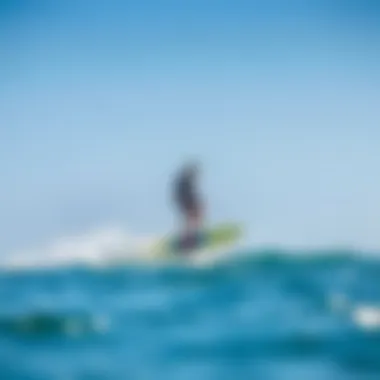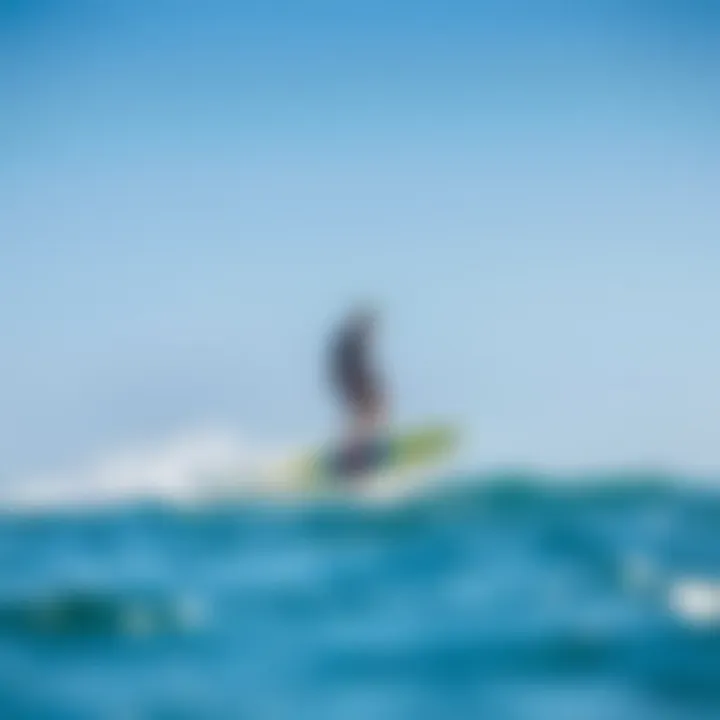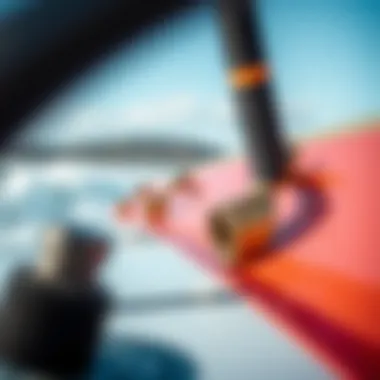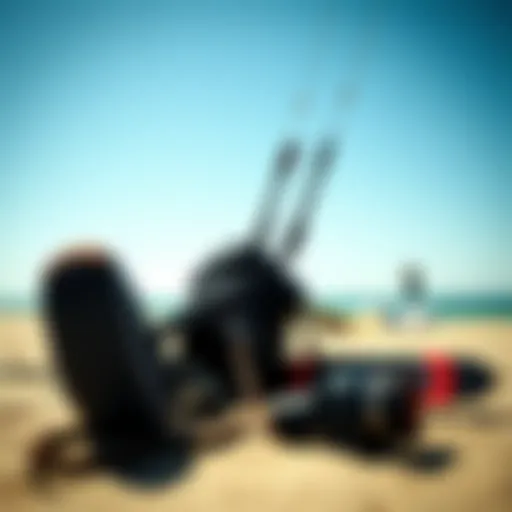Exploring the World of Hydro Foil Surfing Techniques


Gear Insights
Hydro foil surfing showcases a new era in the surfing world. The right gear can elevate your experience, making it essential to understand what’s available and how each piece enhances your ride.
Latest Gear Reviews
When it comes to hydro foiling, the board and the foil are your mainstays. Within the last year, brands like Slingshot and Naish have pushed the boundaries. For instance, the Slingshot Hover Glide boasts an incredibly stable design due to its larger wingspan, making it suitable for beginners and seasoned pros alike. Compared to previous models, the Hover Glide offers better lift and control, particularly in choppy waters.
On the other side, Naish’s Fusion Foil Board is famed for its lightweight construction, which gives a nimble response when navigating waves. Riders report that it’s great for beginners looking to get the hang of balance without being weighed down.
Essential Gear for Beginners
If you're just wading into the world of hydro foil surfing, here’s a quick rundown of what you need:
- Foil Board: Look for shorter boards; they are easier to maneuver.
- Foil: A set up with a larger surface area is ideal for beginners.
- Wetsuit: A good-quality wetsuit is crucial for warmth and comfort in varying water temperatures.
- Leash: This helps to tether the board to you, ensuring it doesn’t drift away after a wipeout.
- Helmet and Impact Vest: Safety first! A helmet protects your head from accidental hits, while an impact vest cushions against hard falls.
Techniques and Tips
Whether you’re fresh to the surfing scene or a seasoned rider looking to broaden your skills, mastering hydro foiling takes practice. It’s not just about simply standing on the board but understanding the mechanics of lift and movement through the water.
Advanced Tricks and Techniques
Once you've got the basics down and can ride comfortably, you might want to try your hand at some tricks. The air jibe, for example, combines maneuvering the board while airborne and can be a stunning display of skill when executed properly. To nail this trick, focus on creating enough lift using your weight distribution and don’t forget to keep your eyes on your landing spot.
For those looking to explore higher challenges, consider practicing the shuvit, which involves the board spinning beneath you. This requires a solid sense of balance and an understanding of how to shift your weight.
Safety Practices for Hydro Foilers
Understanding water conditions is important. Being aware of tides, waves, and weather can save you from unexpected hurdles. It’s also best to foil in areas where there’s enough depth to avoid a hard hit with underwater obstacles. Always check local regulations about foiling in busy areas—it’s about safety as much as fun.
"Hydro foiling is about balancing on a knife’s edge—feel it, respect it, and your rides will thank you."
Closure
Hydro foil surfing opens up a thrilling path for water sport enthusiasts. It revolutionizes the way you experience waves, creating a blend of speed and serenity. With the right gear and techniques, anyone from an adventurous traveler to a curious hobbyist can embrace this sport.
Delve deeper into the community by checking forums and social media groups. Reddit has active threads where you can learn from other enthusiasts, while Facebook groups can connect you with local riders and upcoming events.
For those wanting more detailed information on hydro foiling, visit Wikipedia or dive into specialized guides available through Britannica. Whether you are a surfer, kiteboarder, or simply someone looking to challenge themselves on the water, the journey of hydro foiling is waiting for you.
Understanding Hydro Foil Surfing
Hydro foiling represents a distinct shift in the world of water sports, blending innovation with fascination. Those attracted to this thrilling pursuit find themselves elevated above the surface of the water, gliding effortlessly. But why should one take the time to understand hydro foil surfing in-depth? The answer lies in grasping its complexities and appreciating the nuances that create a unique experience.
Understanding hydro foiling is crucial not just for enthusiasts but also for those contemplating venturing into the sport. For starters, it allows riders to enjoy smoother rides with less resistance, which is particularly appealing to kiteboarders. It opens up a new realm of possibilities, allowing surfers to tackle different types of water conditions which might be challenging with traditional surfboards. Moreover, knowing the fundamentals and history of hydro foil surfing augments one's ability to engage and learn efficiently about advanced techniques.
Definition and Fundamentals
At its core, hydro foiling involves attaching a foil—essentially a submerged wing—to a board. The basic principle is straightforward: as the board gains speed, the hydrodynamic lift generated by the foil elevates it above the water's surface. This lift minimizes drag and allows for an incredibly smooth ride even in choppy waters, an intriguing feature that longtime surfers and newcomers alike appreciate. It's more than just a fancy surfboard; it's about embracing a different interaction with the ocean.
The most apparent elements in hydro foiling include the board, the foil itself, and the rider's skill to balance and maneuver. Riders must navigate weight distribution judiciously, as shifting too far forward or backward can negate lift, bringing them crashing back to the surface. Consequently, understanding how weight impacts the ride is fundamental for any aspiring foil surfer.
Historical Context
The roots of hydro foiling trace back to the early 20th century, but its recent emergence as a sport can be attributed to innovations in materials and design. The foil design we commonly see today was refined through advancements in aerodynamics and marine engineering. In the 1960s, inventor Bob Wood developed one of the first surfboards that utilized the hydrofoil design. However, it wasn't until the 2000s that the sport began gaining traction, spurred by the fitting of foils to kiteboards and then paddle boards and surfboards.
Throughout the years, the community that surrounds hydro foiling has flourished. From small groups of enthusiasts modifying gear in their garages to organized competitions that now draw crowds and create buzz online, hydro foiling has transcended its niche origins. The advent of social media platforms has made it easier for riders across the globe to share techniques, tips, and experiences, fostering a vibrant culture that continues to evolve.
"Understanding the rich history and the evolving techniques of hydro foiling can change the way one interacts with the ocean, making it not just a sport but a lifestyle."
In summary, grasping the definitions, fundamentals, and historical context of hydro foil surfing equips individuals with the knowledge they need to appreciate the art form. It's a journey that not only enhances skills but also enriches one’s connection with the vast water world.
The Mechanics of Hydro Foiling
Understanding the mechanics of hydro foiling is essential for both novice and experienced riders. It’s not just about the thrill of gliding above the water’s surface; it’s about grasping how every component works together seamlessly. From lift generation to the way you balance on your board, an in-depth understanding of these mechanics can significantly enhance your surfing experience and safety. This knowledge serves as the bedrock upon which advanced techniques and maneuvers are built.
How Foils Work
Lift Generation
Lift generation is at the heart of hydro foiling. As the board moves through the water, the foil underneath begins to create lift due to its aerodynamic shape. This lift is largely contributed by the angle at which the foil meets the water, known as the angle of attack. A key characteristic of lift generation is that it allows a rider to ascend above the water surface, which minimizes drag and thus increases speed. This unique capability makes hydro foiling a thrilling option for water sports enthusiasts who crave more than just the standard surfing experience.
The higher the lift, the less resistance you feel, making gliding smoother and faster.
However, the lift generation can be a double-edged sword. While more lift means greater speed, it can also lead to instability if not managed correctly. Beginners may find themselves fighting for balance until they get a grasp of how to modulate their weight and the angle of their foil. This interplay can be challenging but also comes with the rewarding sense of mastering the water beneath.
Hydrodynamics
Hydrodynamics plays a crucial role in understanding how your foil interacts with the water. It studies the behavior of water in motion and how forces like drag and lift can influence performance. The water's flow around the foil is what dictates the stability and maneuverability of the ride. One key aspect to note here is that hydrodynamic efficiency is what allows foils to glide seamlessly. Efficiently designed foils can minimize drag, allowing for longer runs and less effort from the rider.


The beauty of hydrodynamics is that even small adjustments can yield substantial changes in performance. For instance, altering the position of the foil can change how water flows around it, affecting both lift and drag simultaneously. This requires understanding and experience, but it can be the difference between an exhilarating ride and a rather awkward tumble.
Balance and Control
Maintaining balance and control while hydro foiling involves practical techniques that come with practice and patience. Proper balance ensures the rider stays upright and stable, while control allows for the execution of complex maneuvers.
Weight Distribution
Weight distribution is one of the bedrocks of effective hydro foiling. The way you position your body on the board can determine how well you maintain lift and control. A vital component of weight distribution is understanding the shift of your center of gravity. Leaning too far back, for example, might lead to a rearward descent, while leaning too far forward could plunge the foil into the water, a drag-inducing maneuver known as "stuffing."
Efficient weight distribution creates a fluid sense of movement, letting ride smoother and faster. Riders are often advised to keep their weight centered, with slight shifts to navigate turns and adjust to changing water conditions. It’s like a dance with the waves, requiring rhythm and timing.
Stabilization Techniques
Stabilization techniques help maintain your position and control during the ride. These can be a combination of physical adjustments and utilizing the foil's features. A key characteristic of stabilization techniques is that they often involve small movements from the rider to counteract the natural forces acting during surfing, such as waves and wind.
One popular method is to utilize your knees and arms to make subtle adjustments, allowing you to maintain your balance without excessive bodily movements. An often overlooked feature of hydro foiling is that, with practice, you can develop an instinct for these adjustments. This instinctual control not only enhances performance but also improves overall safety on the water.
Equipment Essentials
When it comes to hydro foil surfing, the right equipment can mean the difference between a thrilling ride and a frustrating struggle. This section digs into essential gear, shedding light on the key components that define the experience and how they can enhance performance. With hydro foiling gaining traction, understanding equipment essentials is crucial for safety, skill development, and maximizing enjoyment on the water.
Foil Board Types
All-around Boards
All-around boards are like the Swiss Army knives of hydro foiling. They’re thoughtfully designed to cater to various riding styles and conditions, making them an excellent choice for beginners and enthusiasts alike. The key characteristic of these boards is their versatility—they can handle everything from small waves to flat water sessions.
What sets all-around boards apart is their stability. They tend to have a wider shape and a flatter rocker, which provides balance and makes it easier to learn the ropes. For those just getting their feet wet, this feature is a significant advantage, as it allows riders to focus on mastering their technique without the added pressure of constant corrections.
Nonetheless, it's not all sunshine and rainbows. The disadvantage of all-around boards is that they might lack the speed and agility that more specialized boards can offer. As riders progress, they might feel the need to shift to more advanced options tailored for specific styles.
Race Boards
On the other hand, race boards are engineered for speed and performance, much like race cars in the world of motorsports. Their narrow profiles and elongated lengths enhance hydrodynamics, allowing skilled riders to hit impressive speeds on the water. This aspect makes race boards a favorite for those looking to push their limits in competitive environments.
The unique feature of race boards lies in their streamlined design, a characteristic that aids in minimizing drag. This design can be particularly beneficial during long-distance races where efficiency over distance is paramount. However, the flip side is that such boards can be less forgiving for novice surfers, potentially making early experiences challenging.
Choosing the Right Foil
Deciding on the right foil is akin to picking the engine for a custom-built vehicle. Each rider’s weight, skill level, and desired riding style significantly influence this choice. This aspect is vital and can greatly impact how well one adapts to hydro foiling.
Material Considerations
When it comes to foils, materials can play a pivotal role in defining performance. Most foils are made from either aluminum or carbon fiber, with aluminum being more robust and affordable, making it a solid choice for beginners who may take a few spills.
On the flip side, carbon fiber is lighter and stiffer, offering better lift and performance, which makes it more popular among seasoned surfers. However, its higher price tag can be a deterrent for those just starting. The advantage of investing in carbon fiber is its enhanced durability and performance responsiveness, while aluminum foils may weigh more, but they last longer in the face of wear and tear.
Size and Shape
Size and shape also play critical roles in foil selection. A larger wing surface area generally provides greater lift at lower speeds, making it ideal for lighter riders or those learning the basics. Moreover, a higher aspect ratio tends to deliver better speed and increased efficiency once lift has been achieved.
However, larger wings can be cumbersome in strong wind conditions, as they may become tricky to maneuver. For those looking to ride aggressively or tackle high-speed turns, a smaller, more dynamic foil can be more advantageous but requires a refined sense of balance and control.
Techniques and Skills
Learning the ropes of hydro foil surfing isn't just about having the right gear; it's also deeply tied to the techniques and skills you develop along the way. These skills can mean the difference between a smooth ride and a rather frustrating experience. A solid understanding of the basic and advanced techniques can help riders perform with confidence and unleash their full potential on the water.
Basic Riding Techniques
Starting Off
Getting started on a hydro foil is like learning how to ride a bike, albeit one that keeps sailing over the waves. The process requires slightly different physics and a bit of finesse. When you first set out, it’s essential to have a good stance. Feet shoulder-width apart, knees bent, and weight evenly distributed are vital components to setting yourself up for success. What's special about the starting off technique is that it helps build the foundation necessary for more intricate maneuvers down the line.
One of the biggest benefits of mastering this initial phase is that it gives riders a feeling of control, which is crucial for every windsurfer or kiteboarder. Many newcomers often overlook this part, thinking it’s easy. However, the balance between pressure on the foil and power from the sail is delicate. It’s a beneficial choice to focus on this technique because it lays the groundwork for future skills.
But keep in mind, there’s a unique feature to these starting techniques that can be a double-edged sword. If you're too tentative or lean too far back, you may find your foil drops back down to the water. On the flip side, overcompensating by leaning too far forward can lead to an uncontrolled nosedive. This balance is key and will take time and practice to master.
Maintaining Speed
Now that you’ve started off, it’s all about maintaining your groove. Keeping a consistent speed on the foil is crucial because it helps prevent the board from losing lift. If you slow down too much, you’ll find yourself slipping back into the water, which can feel like hitting a brick wall. The technique for maintaining speed involves a mixture of correct posture and fine-tuning your movements on the board. Riders should focus on subtle shifts in weight and really listen to what the water is telling them. Keeping a smooth, efficient motion helps keep the foil working as intended.
The standout feature is that maintaining speed ties directly to experience. Over time, as you refine your skills, you’ll develop a sixth sense about how to push against the pressure of the foil and how to read how much power you need to channel from your sails or kite. This method brings a notable advantage in the long run, as efficiency is the name of the game in hydro foiling. Riders who become adept at this can enjoy longer, more exhilarating sessions on the water, minus the frustration of frequent crashes.
However, it can be a challenge to keep a level head. The temptation to push too hard in a gust or to oversteer can trip you up, resulting in a loss of speed and a potential wipeout. Staying aware and collected is essential in this technique.
Advanced Maneuvers
Turning Techniques
Once you’ve grasped the basics, it’s time to dive into some advanced maneuvers. Turning techniques are vital for navigating waters with style and control. When it comes to turning, the goal is to shift your body weight strategically to guide your foil through the arc. If done correctly, you’ll not only feel the thrill of carving through the waves; you’ll also be using less energy while doing so. This technique requires an already established proficiency in maintaining speed, as it necessitates a fluid combination of speed management and directional change.


A unique characteristic of the turning technique is its reliance on body positioning and timing. Rigid turns can lead to disastrous outcomes where the foil loses lift. Thus, using a smooth weight shift can ensure you remain airborne, enhancing both performance and enjoyment. This can be particularly useful when trying to catch up with friends or navigate crowded waters. While challenging, mastering these turns provides a dynamic edge to any rider’s repertoire.
On the downside, getting a turn wrong can have repercussions. You run the risk of crashing or losing control, which could throw you into less-than-optimal situations. Understanding how and when to initiate a turn can save you some face on the water.
Jumping and Tricks
Jumping and tricks are where the magic happens. For many riders, jumping is not just an impressive feat; it signifies mastery over the basics and a command over technique. Executing jumps requires much more than simply popping off the water; it involves correct timing, adequate speed, and ample lift generated by the foil. It’s a combination of everything you’ve learned thus far.
The beauty of jumping and tricks is that they bring a sense of joy and excitement. It shows the creative aspect of hydro foiling. Eager to showcase their skills, many riders often create signature tricks that make them stand out in their local communities.
However, jumping can be a double-edged sword. If you miscalculate your lift or timing, you might come crashing down hard — sometimes leading to injuries. The learning curve can be steep, but it ultimately rewards those who are willing to invest the time into honing their techniques. With this skill, a rider can not only increase their performance but also add a touch of flair to their riding style, making it a highly sought-after attainment.
Mastering techniques and skills in hydro foil surfing not only improves your performance but also brings a deeper level of enjoyment to the sport.
Ultimately, whether it’s starting off right or conquering jumps and tricks, honing your skills is what makes the difference between the amateurs and seasoned pros. It’s about becoming part of the intricate dance with water and wind, fully embracing what hydro foil surfing has to offer.
Environmental Considerations
When we think about hydro foil surfing, it's easy to get caught up in the thrilling rush of gliding above the water, but there’s more to this sport than the adrenaline. It’s crucial to also consider its impact on our environment. Understanding the environmental considerations related to hydro foiling helps enthusiasts appreciate the ocean we ride on—protecting it, enriching it, and preserving it for future generations.
Impact on Marine Life
Every wave we ride and every foil that breaks the surface carries with it the potential to affect marine life. Hydro foiling operates in the delicate ecosystem that exists beneath the surface, where fish and other wildlife make their homes. The presence of surfers in the water can disrupt habitats, especially in areas where marine life is already stressed by pollution, overfishing, and climate change.
For instance, sudden movements from a foil can startle fish, pushing them away from their spawning areas. It’s also worth noting that shallow reefs are often home to sensitive species. While hydro foilers tend to avoid the most sensitive areas, it's still good practice to educate oneself about local wildlife and their migration patterns to minimize disturbances.
In addition, quieter, electric-powered hydro foils are becoming popular, offering a less invasive option for those wanting to ride. The reduced noise levels can be beneficial for abundance and variety in marine life; many sea creatures rely on sound for communication, navigation, and hunting.
"Protecting marine habitats is not just a duty; it's a necessity for sustaining the waves we love to surf."
Sustainable Practices
Adopting sustainable practices is essential for hydro foil surfers who care about their impact on the marine environment. By making conscious decisions, individuals can contribute positively to their surroundings. Here are some sustainability tips for hydro foilers:
- Choose Eco-Friendly Gear: When selecting equipment, look for eco-conscious manufacturers that prioritize sustainability, such as those who use recycled materials or sustainable production techniques.
- Ride Responsibly: Always be aware of your surroundings. Stick to designated areas and avoid regions critical for wildlife or restoration projects.
- Pick Up After Yourself: Carry a trash bag to collect any rubbish you might find while surfing. This small act makes a big difference in keeping waterways clean.
- Educate Yourself and Others: Share information with fellow surfers about local ecosystems and the measures that can be taken to protect them.
- Support Conservation Efforts: Many organizations work tirelessly to protect marine environments. Contributing through donations, volunteering, or even participating in local clean-ups showcases commitment to sustainability.
Community and Culture
In the world of hydro foil surfing, the community and culture surrounding the sport play a vital role in shaping experiences and fostering a sense of belonging. Unlike traditional surfing, where the environment is often defined by solitary rides, hydro foiling has developed a vibrant community that encourages connection among enthusiasts of various skill levels. This section explores the diverse aspects of this community, from local groups to online networks, and how they contribute to the overall growth and enjoyment of hydro foil surfing.
Hydro Foil Surfing Communities
Local Groups
Local groups are essential for anyone looking to dive deeper into hydro foil surfing. These communities are often composed of passionate riders who come together to share tips, experiences, and, most importantly, the stoke of foiling. One of the key characteristics of local groups is their ability to create an inclusive atmosphere, where novices don’t feel intimidated.
For example, regions with active hydro foiling scenes, like Hawaii or California, often have meet-ups where members exchange advice on gear and techniques. These gatherings can turn into informal lessons, allowing newer riders to learn from more experienced surfers in a low-pressure setting.
However, local groups can also present challenges. In areas with limited foiling popularity, finding a dedicated community might be tough. That could lead to a feeling of isolation for those keen to learn more. Nonetheless, when it comes to support and camaraderie, local groups are a beneficial choice for fostering relationships and skills in hydro foiling.
Online Communities
On the flip side, online communities provide an avenue for hydro foilers to connect regardless of geographic location. Platforms like Reddit and Facebook host groups where enthusiasts share videos, troubleshooting tips, and the latest trends in hydro foil technology. The beauty of online communities lies in their accessibility; from seasoned pros to curious beginners, all can find a space to engage with others who share their passion.
The specific characteristic of online communities is their ability to foster discussions that can transcend borders. A rider in Australia can share techniques with someone in Portugal, creating a melting pot of ideas and innovations. However, they come with downsides too. Online discussions sometimes lack the personal touch of face-to-face interaction, which can make it difficult to build genuine relationships.
Still, this virtual camaraderie nurtures a broader understanding of the sport, allowing for an exchange of ideas that can drive hydro foiling to new heights.
Events and Competitions
Events, both local and international, bring the hydro foil community together. They serve as a platform for riders to showcase their skills, push their limits, and share the experience with spectators. Competitions focus on various aspects, from freestyle maneuvers to race formats, each offering a unique flavor of foil action.
Participating in or attending these events can be an exhilarating experience. Though thrilling, they also build camaraderie among participants and help cultivate friendships beyond just competition. Plus, these gatherings often include workshops and contests that offer valuable learning opportunities for those looking to improve their skills.
The sense of belonging created within these events fosters loyalty to the sport, further enriching the community aspect of hydro foil surfing.
Quote: "The best part about hydro foiling isn't just the ride; it's the people you meet and the stories you share along the way."
This emphasis on community and culture ultimately highlights the importance of connection in hydro foil surfing. Whether through local meet-ups or virtual forums, it’s clear that the relationships built within these spaces contribute enormously to the growth of the sport.
Traveling for Hydro Foiling
Traveling for hydro foiling is not just a journey, but an adventure that opens the door to new vistas and experiences. The thrill of gliding above the water while surrounded by stunning sceneries makes traveling to different locations a vital part of the hydro foiling experience. Different destinations not only offer varying wave conditions but also unique landscapes that can enrich one's love for the sport. This section covers essential locations, packing tips, and how to prepare effectively for an excursion.
Best Locations Worldwide
Destination Criteria
When looking for the perfect spot to hydro foil, a few criteria come to the forefront. First and foremost, the condition of the water plays a crucial role. Surfers often seek areas with gentle waves, steady wind, and clear waters. Accessibility is also key; easy access to launch sites allows for a more enjoyable experience. In addition, local weather patterns can make or break a trip. An ideal destination should have warm temperatures, preferably year-round.
Some surf destinations worldwide stand out due to their combination of these factors. For example, the coast of Maui in Hawaii is renowned for its consistent conditions, making it a popular choice among hydro foil enthusiasts.


Advantages of Destinations like Maui include:
- Warm waters that are welcoming for beginners.
- Vibrant local culture enhancing the surfing experience.
- A variety of spots for different skill levels.
However, certain areas also face the disadvantage of being crowded during peak seasons, which can hinder the experience. Travelers must weigh these factors to find a location that suits their preferences best.
Hidden Gems
Hidden gems are locations that may not be as well-known but offer breathtaking experiences. These spots might include lesser-known bays or secluded beaches, often providing a tranquil environment away from the hustle and bustle of popular surf towns. For example, places like La Ventana in Mexico offer picturesque vistas and less crowded waters, creating an intimate setting for hydro foiling.
The charm of these hidden locations comes from their unique scenery and the opportunity to connect with nature. Travelers can enjoy serene surroundings while mastering their foiling skills. Some advantages of choosing hidden gems include:
- Less competitive environment, allowing for more focused practice.
- Stunning, unspoiled nature that adds to the adventure.
- Local communities that can provide valuable insight into the best times and areas to surf.
However, such spots may lack infrastructure, like rental shops or surf schools, which could be a hassle for some. Hence, savvy travelers should do a little homework before heading out.
Packing and Transporting Gear
Packing and transporting gear is a critical aspect of traveling for hydro foiling. Both board and foil must be handled with care to ensure they arrive at the destination intact. Here are some tips for packing efficiently and effectively:
- Use a durable board bag with ample padding. This will help protect your gear during transit and can also hold personal items.
- Disassemble your foil and store it safely to prevent any damage during travel. Consider keeping individual components in separate padded cases.
- Check airline regulations to ensure compliance with size and weight restrictions for surf equipment. Some airlines offer special rates for sporting gear, making it worthwhile to do some research.
Clear and organized packing makes for a smoother journey and allows you to focus on the excitement of exploring new waters. Hyd reaching your desired destination, there’s no telling what adventures lie ahead, each fostered through the unique interplay of location, preparation, and passion for hydro foiling.
Safety Considerations
When it comes to hydro foil surfing, safety is not just a checkbox; it's a fundamental piece of the puzzle. Hydro foiling presents a different set of challenges than traditional surfing. The very nature of being elevated above water introduces varied risks. Thus, being mindful of safety measures is of paramount importance to enjoy the sport without unnecessary worries.
Personal Safety Gear
Helmets and Impact Vests
Helmets and impact vests are non-negotiables in hydro foil surfing. The sport can entail high-speed maneuvers, and a helmet protects your noggin from unexpected falls or collisions. Modern helmets are designed not only for protection but also for comfort and fit, which is crucial in a sport that often involves rough waters.
Impact vests, on the other hand, cover your torso to provide cushioning during crashes. They are a smart choice for hydro foiling, as they reduce the impact when you hit the water, making the experience less jarring. Even though these vests can feel a bit bulky at times, their protective benefits far outweigh the inconvenience.
Unique features like quick-dry materials in these vests ensure they don’t weigh you down. Despite some drawbacks, like limited mobility compared to non-vest wear, they are an essential piece in the safety gear mix.
Wetsuits for Weather Protection
Wetsuits serve a dual purpose for hydro foilers: they keep you warm and protect you from abrasions. Depending on the water temperature, they can be a game changer making your time on the water far more enjoyable. A well-fitted wetsuit acts like a second skin, insulating body heat while allowing for good mobility—essential when trying to maintain balance on a foil board.
Choosing the right wetsuit relates back to the specific water conditions you will be navigating. Standard options like a shorty are great for warmer climates, whereas a full suit is better suited for chillier waters. The downside? They can get a bit snug after a while, potentially reducing flexibility. However, when you consider the protection against elements like wind and cold water, their benefits are clear.
Navigating Water Conditions
Navigating water conditions is vital for anyone who enjoys hydro foiling. Water doesn’t always behave the way you expect, so understanding its nuances can save you from potentially dangerous scenarios. Being aware of your surroundings elevates your safety game and boosts overall surfing skills.
Understanding Waves
Being able to read waves is key in hydro foiling. Waves can change rapidly, and understanding their patterns helps surfers anticipate how they will behave. Recognizing the difference between a perfect wave and a potentially hazardous one can dramatically affect a rider's safety.
The benefit of mastering wave dynamics is that it informs decision-making regarding when to paddle out or when to stay closer to the shore. Mistakes in understanding wave movements can lead to wipeouts and serious impacts. This knowledge serves to enhance both your experience and your longevity in the sport.
Current Awareness
Current awareness cannot be overstated. Ocean currents can be tricky and often don’t match seamlessly with the movements of waves. Therefore, being aware of currents helps in planning where to ride, going against or utilizing them to your advantage during a session.
Understanding how currents affect your trajectory and energy levels can make or break a session. When you're aware of the forces at play, you can enjoy your time on the water without losing track or getting swept away into unwanted territories.
Ultimately, maintaining a safety-first mindset is essential when heading into the world of hydro foil surfing. It informs every aspect of the experience—from utilizing the right gear to navigating unpredictable water conditions—all aimed at ensuring that you're primed for an enjoyable day on the waves.
Future Trends in Hydro Foil Surfing
As hydro foil surfing continues to gain traction among water sports enthusiasts, understanding the future trends is crucial. This section sheds light on advancements in technology and adaptations in technique that promise to shape this sport. The growing popularity of hydro foil surfing indicates a shift not only in the sport itself but also in how surfers engage with the ocean.
Technological Advancements
The world of hydro foiling is not static; it’s evolving as rapidly as the waves at the beach. Innovations are driving changes that increase performance and accessibility. Here are some noteworthy advancements:
- Material Innovations: The development of lighter and stronger materials such as carbon fiber and advanced plastics is crucial. These materials enhance the durability of boards and foils while minimizing weight, making it easier for surfers to maneuver.
- Improved Hydrodynamics: Engineers are designing foils that provide greater lift and stability with less drag. This evolution leads to smoother rides and can help beginners maintain control more easily.
- Electric Foiling: The introduction of electric-powered foils marks a turning point for hydro foiling. These hydrofoils include a small motor to help surfers ride in areas where natural wind or waves may not suffice, broadening the scope of potential locations and making foiling more accessible to enthusiasts everywhere.
"Every innovation pushes the boundaries of what’s possible in hydro foiling, ensuring that both beginners and seasoned surfers will enjoy new experiences."
- Smart Accessories: Wearable tech, including tracking devices and sensors attached to boards, are paving the way for a smarter surfing experience. These devices can monitor performance metrics like speed, elevation, and distance achieved. This data-driven approach helps surfers refine their techniques.
The integration of these advancements makes hydro foiling not only more exhilarating but also safer. The continuous march of technology means that today’s beginners can find themselves on the same level as seasoned surfers much more quickly than before.
Evolving Techniques and Styles
As equipment improves, the techniques and styles used by hydro foilers are adapting, evolving into distinct forms. This transformation is fueled by both individual creativity and shared community knowledge. Here’s how techniques and styles are changing:
- Hybrid Techniques: Surfers are blending different styles, such as traditional surfing, kiteboarding, and wakeboarding, creating unique riding techniques. This hybridization allows for a rich array of maneuvers and experiences.
- Progressive Riding: The trend of pushing boundaries is evident, with surfers increasingly exploring higher jumps and complex tricks. Advances in foil technology support this push, allowing surfers to execute tricks with grace and precision.
- Freestyle vs. Distance Foiling: There’s a clear divide between those focusing on freestyle and those who enjoy long-distance rides. Freestyle riders are exploring elaborate maneuvers, while distance foilers are prioritizing endurance and speed across open water.
- Community-Driven Evolution: Online forums and groups, such as Reddit and Facebook communities, are fostering a sharing culture. Riders swap ideas, techniques, and styles, leading to rapid evolution within the sport. Enthusiasts are increasingly influenced by global trends, adapting popular maneuvers from different regions.
This ever-changing landscape of techniques keeps water sports fresh and stimulating, encouraging more participants to pick up a foil and join the exhilaration of gliding above water.
In sum, the future of hydro foil surfing holds much promise. By welcoming technological innovations and celebrating evolving styles, the sport is poised not only to captivate newcomers but also to retain the interest of seasoned surfers. The ocean may hold countless surprises, and hydro foil surfing will continue to unveil them.















